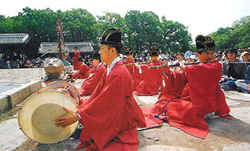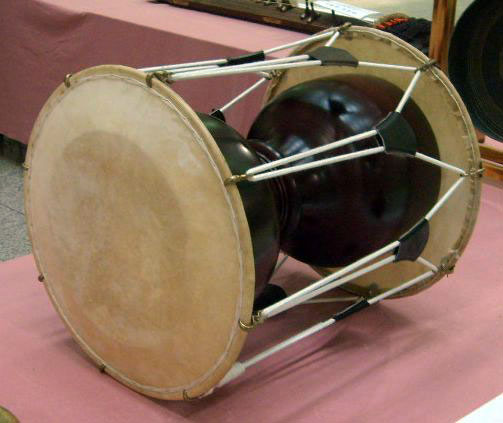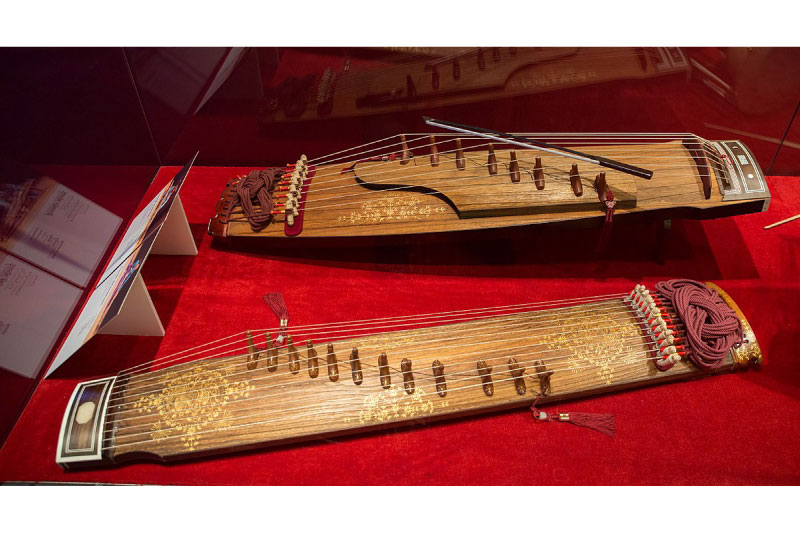
Genre, Context, and Style
Traditional Korean music may be introduced in the context of the hierarchy of court music, folk music, and in-between. It can also be classified by regions, such as Northwestern, Central, Southwestern, Eastern Coastal, and Jeju Island as they differ stylistically. It can as well be classified in terms of functionality, such as ceremonial, celebratory, processional, leisure, labor, healing, purging, or praying.[9]For comprehensive summary of Korean musical genres, functions, descriptions, and accompanying instruments, visit Classical Korean Music (http://www.angelfire.com/alt/koreanmusic/classical.html) All are referred to as kugak, "national music," for being "old" and "Korean."
These musical genres are reconstructed on the modern stage with muddied regional, functional, or social hierarchical classifications.Through closer listening, this part hopes to find the connection between the genres, musical styles, and performance contexts of several of the vocal and instrumental genres.
Sanjo
Widely introduced in its literal translation, "scattered melodies or modes," sanjo is a solo instrumental music accompanied on ch'anggo , the Korean hourglass drum. Some experts argue that "scattered" is derogatory: when court musicians first heard it, they did not accept it as music but rather as a "disorganized collection of scattered modes."[10]Traditional Korean Music (http://www.angelfire.com/alt/koreanmusic/folk.html) Artistic taboos were breaking at the end of the Chosôn dynasty, and the instruments previously used exclusively for court music were being played by the flamboyant hands of "new age" musicians. The critical ears of the court musicians found the new music flashy, unorthodox, and "scattered."
Sanjo is a highly developed art of improvisation-if not "high art" like court music-that deftly employs melodic phrases and modes and requires the highest level of musical intuition and skill. What do we mean by "improvisation?" Is it composing while playing? Yes, since a musician builds and adjusts a melodic path by employing phrases and movements that come to mind while playing. And no, because these phrases and movements are not something created spontaneously but have been accumulated over many generations, just as language vocabularies are accumulated over many generations. After years of embodying them, a musician could begin to flexibly employ the melodic vocabularies for musical interpretation, just as you formulate sentences with your choice of words and phrases.
The first sanjo experiment is credited to Kim Ch´angjo (1865-1920) on kayagûm around 1890, and the flamboyantly jazzy musical style was quickly adopted onto other instruments such as kômun´go, taegûm (transverse bamboo flute), ajaeng (six-string bowed zither), and haegûm (two-string vertical fiddle).
A sanjo piece typically moves through the following rhythmic cycle, from slow to faster, reaching the climax, then slowing down to the finish. This cycle is also typical of salpuri and shinawee.
| Rhythmic Cycle | |
|---|---|
| Chinyang | Slow six-beat |
| Chungmori | Medium twelve beat |
| Chungjungmori | Faster twelve beat |
| Ônmori | Asymmetrical ten beat |
| Chajinmori | Syncopated four beat |
| Hwimori | Fast four beat with accent on the first beat |
| Conclude in slow chungmori |





Trot (Teuroteu) is the oldest type of Korean pop music originating during Japanese rule in the first half of the 20th century.







